Which is the highest waterfall in the world? Waterfalls possess a captivating charm that’s hard to put into words. They consistently rank high on travel wish lists and are often safeguarded by park systems or UNESCO titles. Every year, countless individuals journey across the world to experience the mesmerizing sight of water cascading from great heights.
With over 60% of our planet enveloped in water, the sight of water tumbling over cliffs and rocks is truly one of nature’s most splendid displays. As for the most breathtaking waterfall on earth? Determining that is a complex task because waterfalls can be measured either by their width or height. In this article, we showcase the top 30 Biggest Waterfalls in the World (Longest, Tallest, and Most Volume). While some may be challenging to access, we’re here to unveil their majestic allure.
Top 10 Biggest (Longest) Waterfalls in The World
The world is home to many breathtaking waterfalls, but the following are the most spectacular in terms of size, height, and sheer beauty. These are the must-visit largest waterfalls in the world.
Khone Phapheng Falls
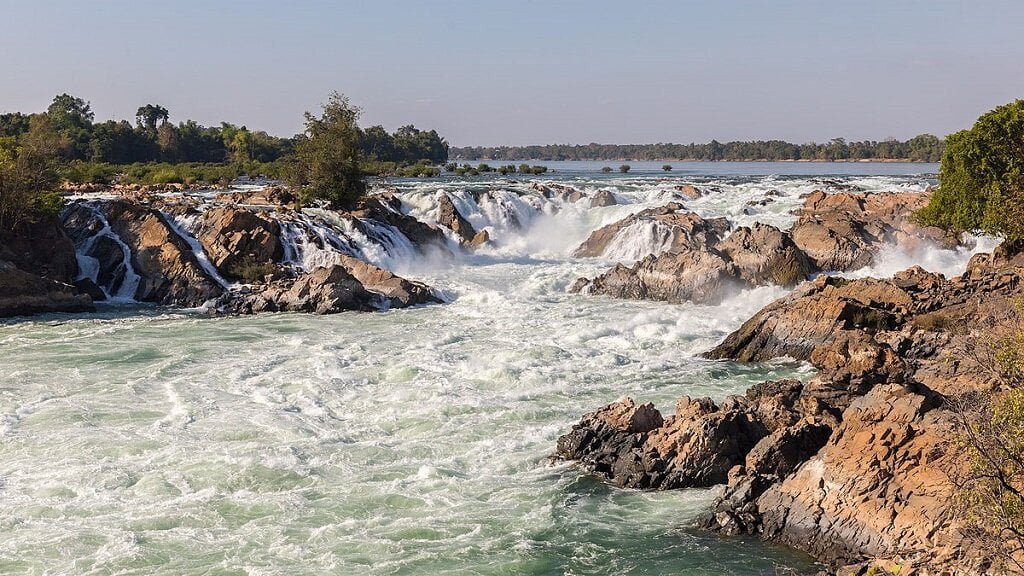
- Width: 35,376 feet
- Height: 69 feet
- Location: Ban Hang Khone, Laos
Situated on the Mekong River in Laos, Khone Phapheng Falls is the widest waterfall in the world. Spanning 35,376 feet, it is a blend of both the Khone and Pha Pheng Falls. The falls boast a staggering flow rate of 2.5 million gallons, which is double the volume of Niagara Falls. The falls were so massive that they effectively halted Chinese trade along the Mekong River.
Pará Falls
- Width: 18,399 feet
- Height: 210 feet
- Location: Bolivar, Venezuela
Located in Bolivar, Venezuela, Pará Falls stretch approximately 18,400 feet across the Rio Caura. Due to the region’s challenging geography, the falls are extremely difficult to access and remain untouched by dam development.
Read More: Clear Water Beaches in Florida
Kongou Falls
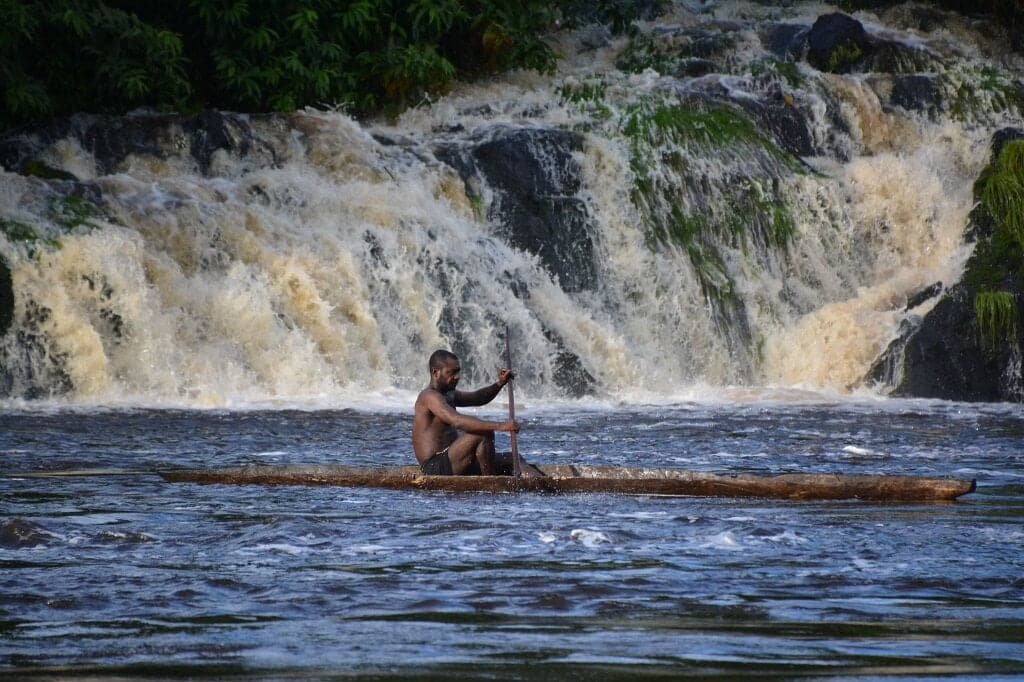
- Width: 10,500 feet
- Height: 185 feet
- Location: Ivindo National Park, Ogooue-Ivindo Province, Gabon
Kongou Falls in Gabon is one of the most powerful waterfalls in the world, with a width exceeding 10,000 feet. Nearly 32,000 cubic feet of water rushes through it every second. The falls are a part of the Ivindo River and are uniquely characterized by multiple streams and cascades that are interspersed with islands. The falls seamlessly blend into the surrounding rainforest.
Iguazu Falls
- Width: 8,976 feet
- Height: 269 feet
- Location: Argentina and Brazil
Although shorter than many other massive waterfalls, Iguazu Falls compensates with its volume, particularly during the wet season. The falls are a series of over 275 individual cascades and boast an average flow rate nearly equivalent to that of Niagara Falls. The falls serve as a natural border between Argentina and Brazil and attract about 1.5 million visitors annually.
Mocona Falls
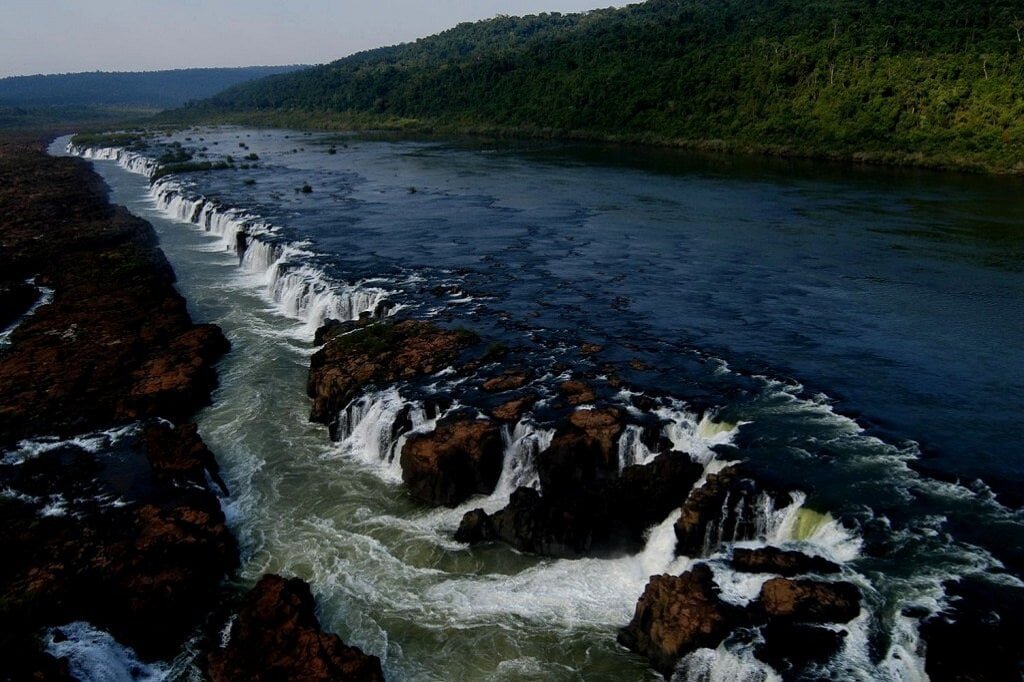
- Width: 6,775 feet
- Height: 66 feet
- Location: Misiones, Argentina
While Mocona Falls may not be the tallest on this list, it is noteworthy for its extensive width along the Uruguay River, stretching for 6,775 feet. The river actually submerges the falls for up to 150 days each year due to unique geological features. Visibility of the falls depends on the water level, making its name Mocona—meaning “to swallow everything” or “the big fall” in various indigenous languages—quite fitting.
Vermilion Falls
- Width: 6,000 feet
- Height: 15 feet
- Location: Vermilion, Alberta, Canada
Vermilion Falls, located on the Peace River in northern Alberta, spans a whopping 6,000 feet. Though it’s technically a waterfall, it’s more aptly described as a series of chutes and rapids, making it an adventurer’s paradise, particularly for kayakers. Originating from the cold water of the Rocky Mountains, these rapids are situated downstream from Fort Vermilion. However, it’s essential not to mix it up with another Vermilion Falls in Minnesota, which is petite but visually appealing.
Read Also: Best Glass Pebble Beach Florida
Victoria Falls
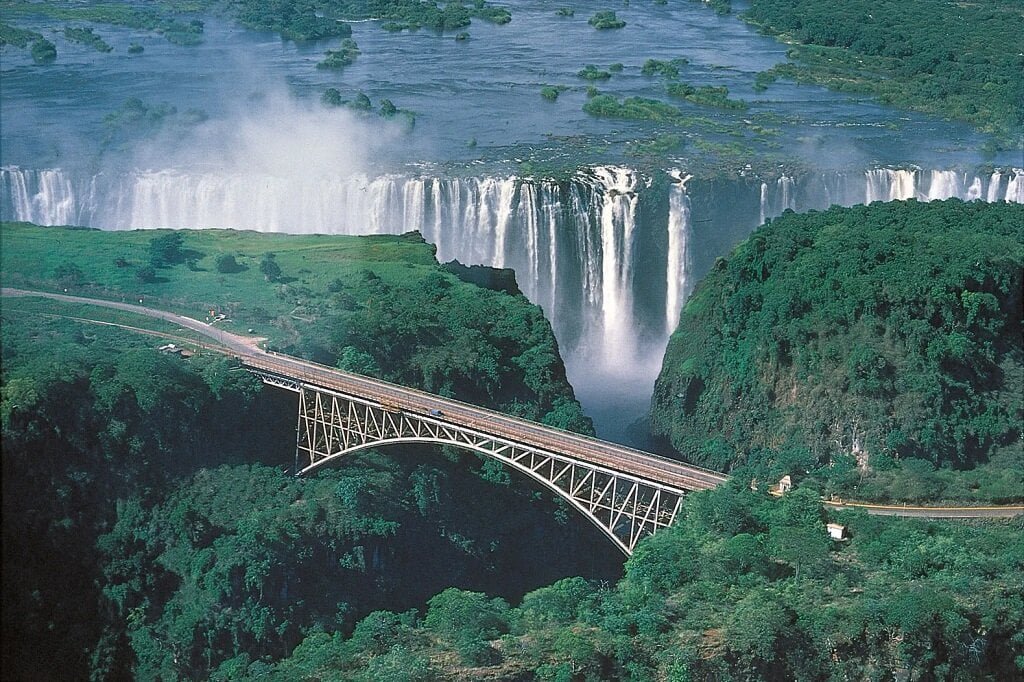
- Width: 5,600 feet
- Height: 354 feet
- Location: Zimbabwe, Africa
Victoria Falls, straddling Zimbabwe and Zambia, is a top attraction in Africa. While not the world’s widest or tallest, its combination of both dimensions results in an awe-inspiring sheet of cascading water. The falls are a part of the Zambezi River, which marks the boundary between the two African countries. The local name, Mosi-oa-Tunya, means “the smoke that thunders.” Named by David Livingstone, an explorer who is believed to be the first European to witness them, the falls commemorate Queen Victoria.
Wagenia Falls
- Width: 4,500 feet
- Height: 200 feet
- Location: Orientale, Democratic Republic of the Congo
Wagenia Falls, despite its considerable volume and width, may not take your breath away visually. The waterfall is a result of the Lulaba River’s mighty flow, likened more to rapids than a traditional waterfall. It’s renowned for the Wagenia fishermen who inhabit its shores. Also known as Boyoma, Kisangani, or Stanley Falls, the latter name is a colonial relic and isn’t popular locally.
Niagara Falls
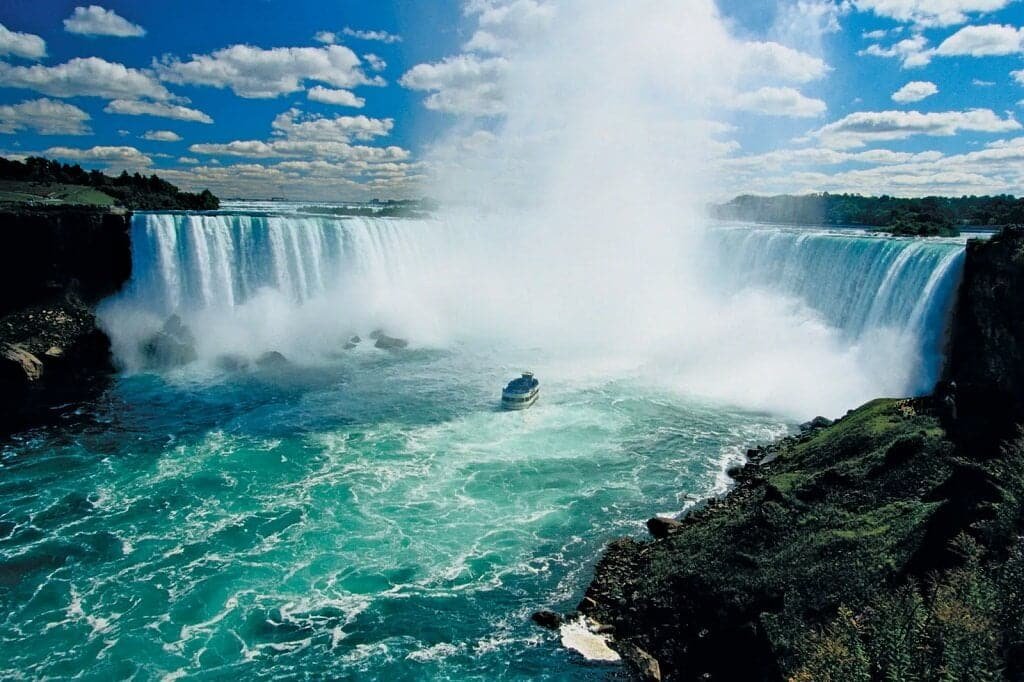
- Width: 3,950 feet
- Height: 167 feet
- Location: USA and Canada, North America
Positioned between Ontario and New York, Niagara Falls is a global icon. Though not the tallest, its flow rate of 1,834 cubic meters every second is formidable. The sound and sight of its cascades are unforgettable. The waterfall, linking Lake Erie and Lake Ontario, comprises three sections. The American Falls and Bridal Veil Falls are on the U.S. side, while the Canadian Falls are on Canada’s side. Annually, around 12 million people flock here, exploring it by boat, helicopter, or foot.
Also Read: Best Nude Beaches in Florida
Inga Falls
- Width: 2,999 feet
- Height: 315 feet
- Location: Kinshasa, Democratic Republic of the Congo
Inga Falls, although not fitting the usual waterfall image, is nonetheless teeming with water. Located in the lower Congo River, it’s the 10th widest waterfall in the world, stretching almost 3,000 feet. With a flow rate dramatically surpassing that of Niagara Falls, this site transformed into a hydroelectric dam in 1972, powering the Katanga province today.
Top 10 Biggest (Tallest) Waterfalls in The World
Angel Falls

- Height: 3,212 feet
- Width: 500 feet
- Location: Canaima National Park, Bolívar, Venezuela
Situated in Canaima National Park in Venezuela, Angel Falls, also known as Kerepakupai Merú, holds the record for the tallest unbroken waterfall, measuring 3,212 feet in height. Located deep within the southeastern Venezuelan jungle, the only way to reach these majestic falls is via airplane and then a boat ride along the Churun River. Exploring Angel Falls is best done from either its summit or base, where you can even swim in the natural pools. However, due to Venezuela’s political instability, visitor numbers have dwindled.
Tugela Falls
- Height: 3,110 feet
- Width: 50 feet
- Location: Royal Natal National Park, KwaZulu-Natal, South Africa
Tugela Falls, located in South Africa’s Royal Natal National Park, is renowned for its five dramatic drops totaling 3,110 feet. This makes it Africa’s tallest and the second-tallest waterfall in the World. It also has the distinction of being the planet’s tallest cascading waterfall. There is an ongoing debate about its precise height, which if verified could surpass Angel Falls as the world’s tallest.
Tres Hermanas Falls
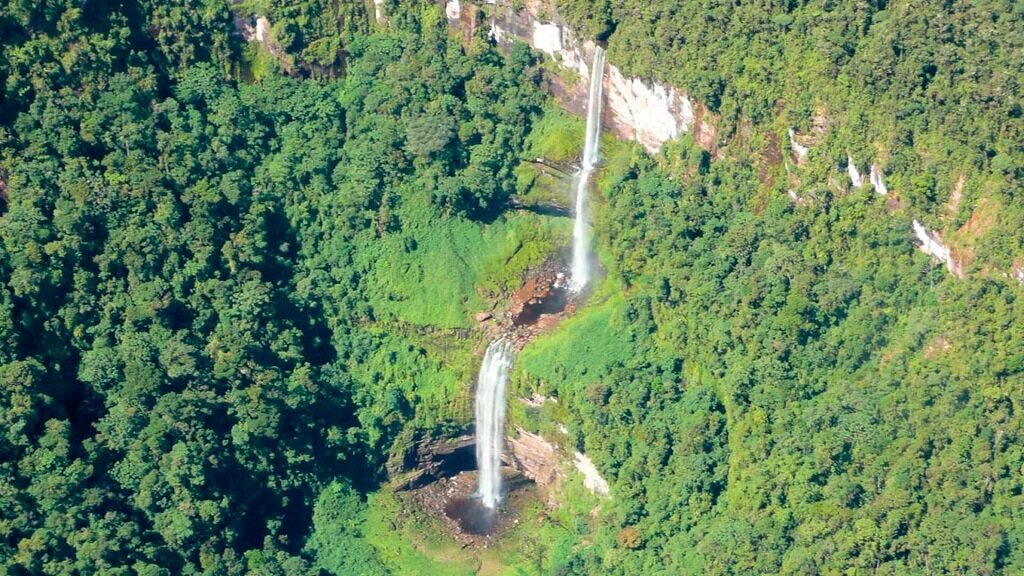
- Height: 2,999 feet
- Width: 39 feet
- Location: Otishi National Park, Junin Region, Peru
Located in Otishi National Park in Peru, Tres Hermanas, or “Three Sisters,” stands as the third-tallest waterfall in the world with a height of 2,999 feet. This waterfall is named for its three distinct sections and is fed by the Cutivireni River. It’s set amid a stunning montane forest, enhancing its natural beauty.
To Know More: Best Nude Beaches in the World
Olo’upena Falls
- Height: 2,953 feet
- Width: 40 feet
- Location: Molokai, Hawaii
Olo’upena Falls, the fourth-tallest waterfall in the world, can be found on the remote Hawaiian island of Moloka’i. It cascades 2,953 feet down from the Haloku Cliffs. Due to its secluded location, the falls can only be accessed by sea or air, making it a hidden gem best viewed during the rainy season from November to March.
Yumbilla Falls
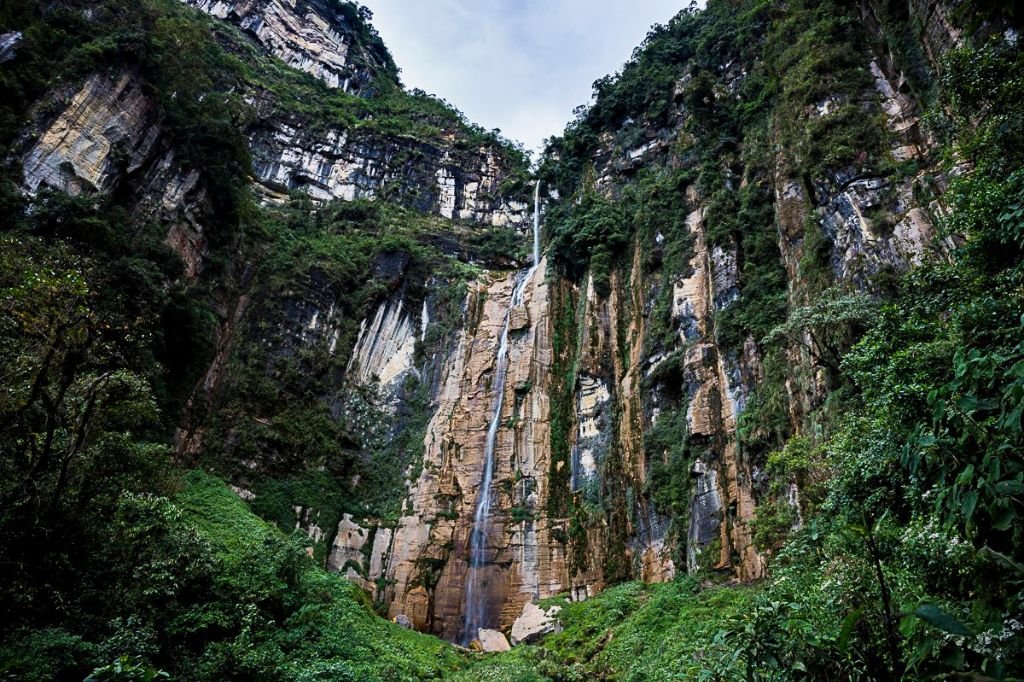
- Height: 2,938 feet
- Width: 25 feet
- Location: Cuispes, Peru
Situated in the Amazon rainforest in northern Peru, Yumbilla Falls plunges 2,940 feet, ranking it the fifth-tallest waterfall in the world. Despite its height, it is often overshadowed by the nearby Gocta Waterfall, which is also impressive but not as tall. A hike through the rainforest to see Yumbilla’s four tiers is an experience not to be missed.
Vinnufossen Waterfall
- Height: 2,822 feet
- Width: 125 feet
- Location: Sunndalsøra, Sunndal, Møre og Romsdal, Norway
Vinnufossen is known as Europe’s tallest waterfall, with a nearly 2,840-foot (865-meter) vertical drop. It is a glacier-fed natural wonder and serves as the focal point among a range of waterfalls near Sunndalen, Norway. All these falls spring forth from a towering rock bluff, each creating a unique indentation in the cliff’s surface. Vinnufossen’s continued trajectory earns it considerable admiration and awe from spectators.
Pu’uka’oku Waterfall
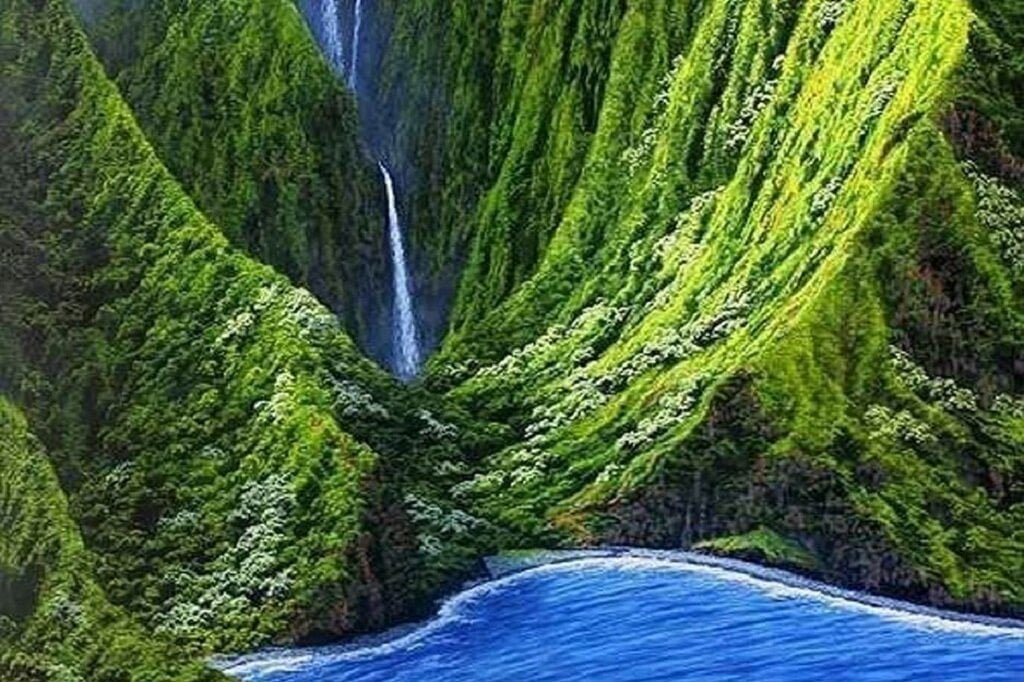
- Height: 2,756 feet
- Width: Not specified
- Location: Molokai, Hawaii
Hawaii is famous for its spectacular waterfalls set in lush jungles, and Molokai Island boasts the world’s tallest among them. Pu’uka’oku Falls plunges from a height of 2,756 feet at the Haloku Cliffs on the northern side of Molokai. The only means to view this stunning fall are by boat or helicopter.
You Can Read: Natural Springs in Florida Near Orlando
Balaifossen Waterfall
- Height: 2,510 feet
- Width: 25 feet
- Location: Ulvik, Vestland, Norway
Situated near Osafjord in Ulvik, Norway, Balaifossen is a meandering waterfall with a height of 2,510 feet (765 meters). During the warmer seasons, the waterfall’s flow dwindles to almost nothing. The waterfall draws its supply from melting snow at higher altitudes, causing its appearance and flow to change significantly across seasons and years. A particularly warm year might reduce the waterfall’s typical width of about 20 feet (6.1 meters) to barely a trickle.
James Bruce Falls
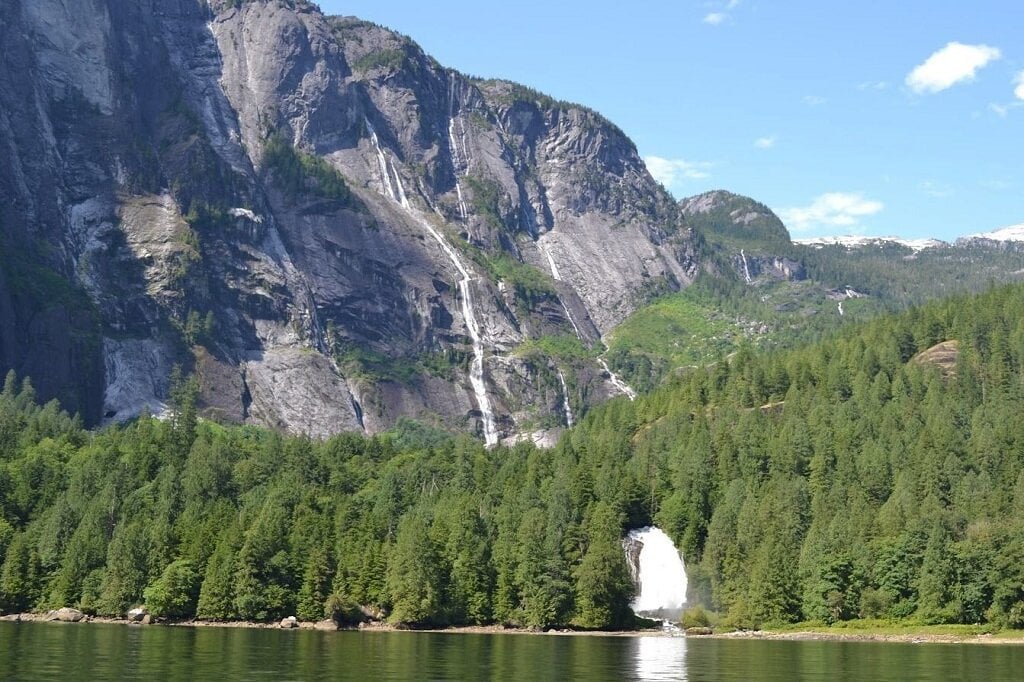
- Height: 2,760 feet
- Width: 15 feet
- Location: British Columbia, Canada
While Hawaii has the tallest waterfalls in the U.S., James Bruce Falls claims the title for the highest waterfall in mainland North America, as well as the ninth tallest in the world. Located in Princess Louisa Marine Provincial Park in British Columbia, the falls plummet from a height of 2,755 feet into Princess Louisa Inlet. The park is encircled by towering granite mountains capped with snow, reaching elevations around 7,000 feet. The waterfall originates from two adjacent streams fed by snowfields—one melting by mid-summer and the other remaining frozen throughout the year. It eventually flows into Loquilts Creek, near the more renowned Chatterbox Falls.
Browne Falls
- Height: 2,031 feet
- Width: 40 feet
- Location: Fiordland National Park, New Zealand
The tallest waterfalls in Australasia are found in New Zealand, with Browne Falls ranking as the nation’s highest and the 10th tallest globally according to this list. However, there’s some debate over whether it surpasses Sutherland Falls, another high waterfall in New Zealand. Browne Falls originates from a height of 2,030 feet (619 meters), cascading through a series of frothy drops before plunging into a thick, wooded ravine. The lower portion of the falls is concealed by dense foliage, making it hard to observe for the casual viewer.
Top 10 Biggest (Volume) Waterfalls in the World
Inga Falls
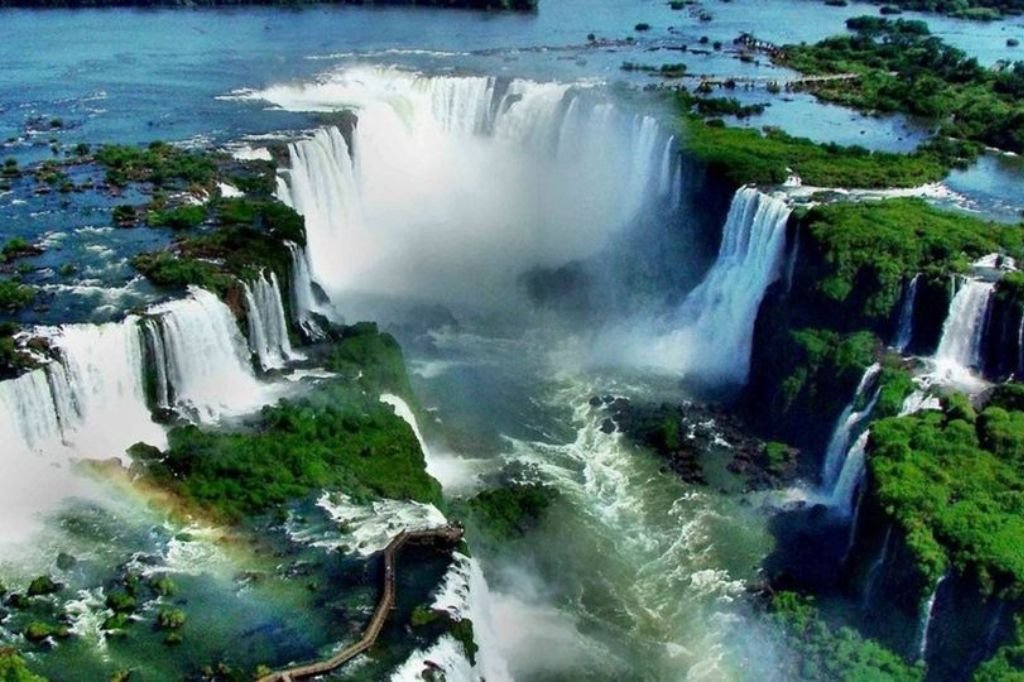
- Width: 2,999 feet
- Height: 315 feet
- Volume: 910,000 ft³/s
- Location: Kinshasa, Democratic Republic of the Congo
Regularly cited as one of the world’s most voluminous waterfalls, Inga Falls is situated in the Democratic Republic of Congo and originates from the Congo River, the world’s ninth-longest river. Although it has a modest height of 315 feet, the falls extend over 9 miles and boast an exceptional average width of 3,000 feet, reaching up to 2.5 miles at its broadest point. While many regard its flow as more akin to rapids, the falls do feature one sharp drop of approximately 70 feet, solidifying its classification as a waterfall. Inga Falls is also the site of a massive hydroelectric dam and is near Livingstone Falls, another voluminous waterfall.
Read More: Shoshone Falls
Livingstone Falls
- Width: 984 feet
- Height: 660 feet
- Volume: 885,000 ft³/s
- Location: Kongo Central, Democratic Republic of the Congo
Livingstone Falls consists of a series of 32 rapids and cascades on the Congo River, stretching approximately 220 miles between Kinshasa and Matadi. Despite featuring only minor rapids along an 87-mile stretch to Isangila, the entire waterfall drops around 850 feet. Named after Scottish explorer David Livingstone, they were first mapped by Henry Morton Stanley in 1877. These falls not only impede navigation from the river’s mouth to the interior but also offer significant hydroelectric potential, as evidenced by the Inga dam project.
Wagenia Falls
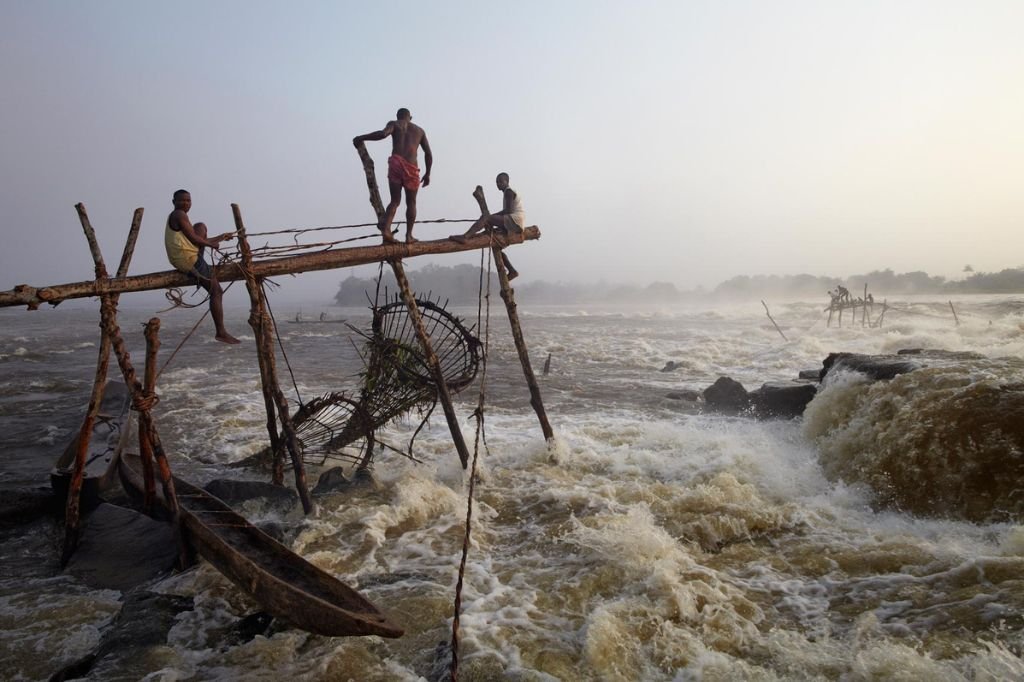
- Width: 4,500 feet
- Height: 200 feet
- Volume: 600,000 ft³/s
- Location: Orientale, Democratic Republic of the Congo
Although not particularly striking in appearance, Wagenia Falls is globally significant for its volume and width. Like its counterpart Inga Falls, Wagenia has more of a rapid flow than a traditional waterfall. It’s notable for the Wagenia fishermen who inhabit its banks. Also known as Boyoma, Kisangani, or Stanley Falls, the latter name is not popular among locals due to its colonial origins.
Salto del Guairá Falls
- Width: 1,250 feet
- Height: 375 feet
- Volume: 470,000 ft³/s
- Location: Paraná, Brazil
Also known as Salto das Sete Quedas, Salto del Guairá was a natural marvel made up of 19 large waterfalls that had a flow rate nearly triple that of Niagara Falls. Covering almost 4 km and reaching heights of up to 170 meters, the falls’ sound could be heard from 30 km away. Guaíra was once Brazil’s most visited city, with the falls attracting people globally. Though no longer in existence, those who witnessed its grandeur often describe it as incomparable, even to the magnificent Iguazú Falls.
Khone Falls
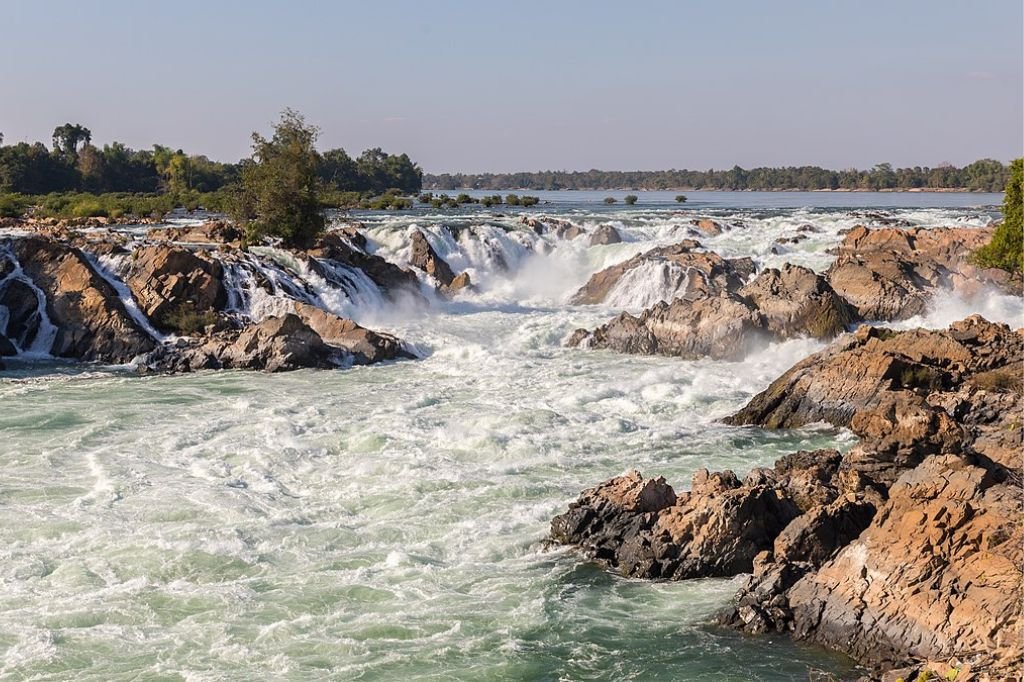
- Width: 35,376 feet
- Height: 69 feet
- Volume: 410,000 ft³/s
- Location: Ban Hang Khone, Laos
Situated near the Laos-Cambodia border, Khone Falls acts as a natural barrier that makes the Mekong River unavailable for trade. Despite its modest height of 69 feet, the falls have an extraordinary width of over 35,000 feet, making them the world’s widest. Their visibility is greatest during drier periods; they practically vanish into rough currents during the monsoon season. The falls are also home to playback, an endangered species of catfish, which is one of the largest freshwater fish globally.
Read Also: Things to Do in Twin Falls Idaho
Celilo Falls
- Width: 5,249 feet
- Height: 20.01 feet
- Volume: 189,500 ft³/sec
- Location: Oregon, United States
Once located east of The Dalles on the Columbia River, Celilo Falls was part of a nine-mile-long indigenous fishing region. At this point, the river narrowed dramatically, creating violent rapids that were fertile fishing grounds. Human settlement near the falls dates back at least 11,000 years. The number of native populations declined significantly due to diseases following contact with Europeans.
Kettle Falls
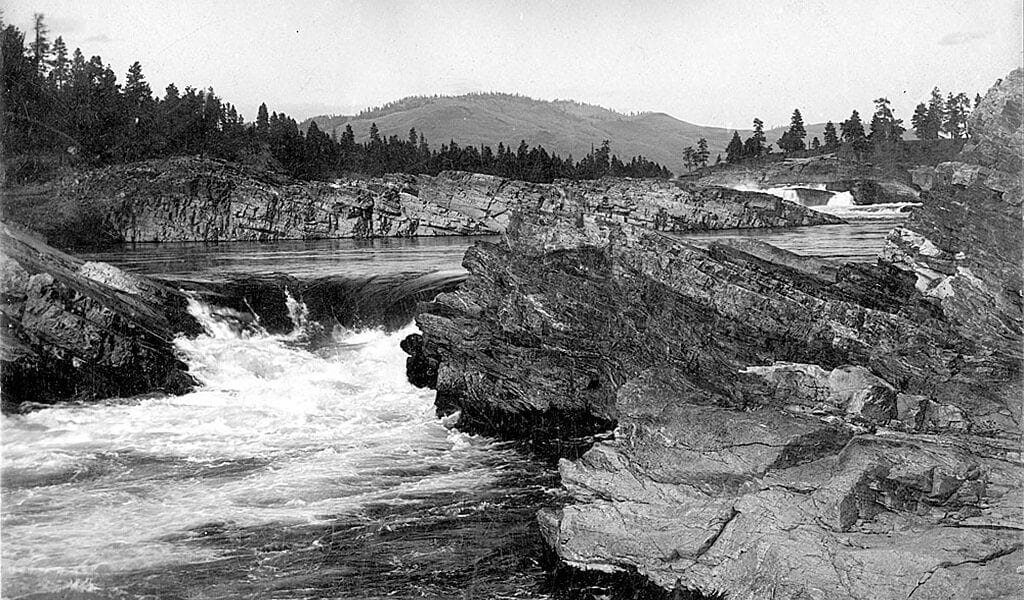
- Width: Unknown
- Height: 50 feet
- Volume: 165,340 ft³/sec
- Location: Washington, United States
In northeastern Washington, Kettle Falls was a crucial Native American fishing spot on the Columbia River. Now submerged due to the construction of the Grand Coulee Dam in 1940, it was once a bustling center for fishing and trade. Native Americans traveled to this site from areas as far as present-day Montana to fish and trade.
Para Falls
- Width: 18,399 feet
- Height: 210 feet
- Volume: 125,000 ft³/sec
- Location: Bolivar, Venezuela, South America
Situated in Bolivar, Venezuela, Para Falls is an awe-inspiring natural feature formed by the Cauro River splitting around an 8-mile-long island. The two streams cut through gorges before rejoining in a massive horseshoe shape, making it a breathtaking spectacle.
Paulo Afonso Falls
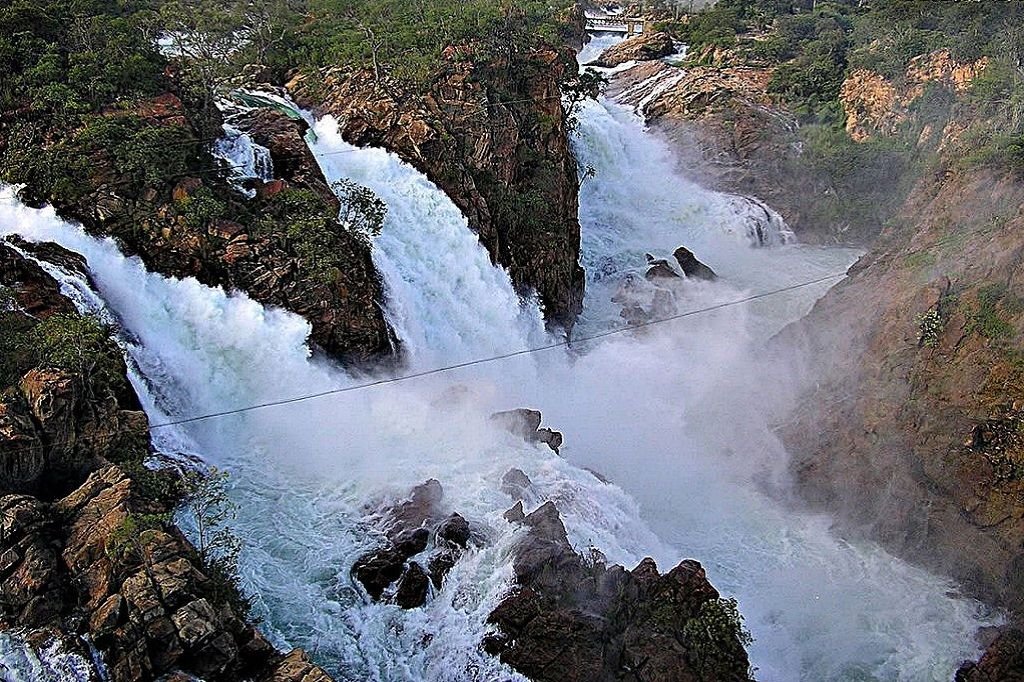
- Width: 60 feet
- Height: 275 feet
- Volume: 100,000 ft³/sec
- Location: Bahia, Brazil
Located on the São Francisco River along the border of Bahia and Alagoas states in Brazil, Paulo Afonso Falls consists of a series of rapids and three cataracts. A large hydroelectric facility and dam have altered the natural flow of the river. However, the dam’s floodgates can be opened to restore the water flow over the falls. Before the construction of the dam, the falls had an average discharge of 100,000 cubic feet per second.
Also Read: The Best Beaches In Vasto, Italy
Salto do Urubupunga Falls
- Width: 6,660 feet
- Height: 42 feet
- Volume: 97,000 ft3/sec
- Location: Mato Grosso, Brazil
Salto do Urubupunga is a mesmerizing natural spectacle located in Brazil. Nestled within the lush greenery of the Brazilian rainforest, this waterfall captivates visitors with its roaring cascades and misty ambiance. A haven for biodiversity, the surrounding region is teeming with unique flora and fauna. The name ‘Urubupunga’ is derived from indigenous languages, adding to the mystical aura of this natural wonder. For travelers seeking a blend of adventure and tranquility, Salto do Urubupunga promises an unforgettable experience.
Frequently Asked Questions (FAQs) about Biggest Waterfalls in the World
What is a Waterfall?
A waterfall is a geographical feature where water cascades down from a height, usually over a steep surface or cliff, into a body of water below. While the heights of waterfalls can vary, they generally occur from elevated locations.
How is the World’s Largest Waterfall Measured?
Determining the world’s largest waterfall can be complex and depends on the criteria used for measurement. While some might look at the height of the waterfall’s longest single drop, a more comprehensive approach is to consider the total width of the cascading system. The latter method has been employed to identify the largest waterfall in this context.
What Waterfall Has the Longest Single Drop?
The longest uninterrupted vertical drop of any waterfall is found at Angel Falls, with a staggering height of 2,648 feet. This waterfall is situated in an isolated area of Venezuela.
The sheer height of Angel Falls is so extreme that the water turns into mist by the time it reaches the ground. At peak flow, the mist from the falls can be felt as far away as a kilometer.
What is the Largest Waterfall in the World?
Khone Phapheng Falls holds the title of the world’s largest waterfall by width. Located on the Mekong River near the Cambodia-Laos border, these falls posed significant challenges for colonial navigators attempting to traverse the river.
What is the Tallest Waterfall in the World?
The tallest natural waterfall on Earth is Tugela Falls, with a total height of 3,225 feet. Although there has been some debate about whether it surpasses Angel Falls, recent measurements using more accurate techniques suggest that Tugela Falls is taller than Angel Falls by approximately 4 meters. Tugela Falls is a seasonal waterfall located in South Africa’s Royal Natal National Park.





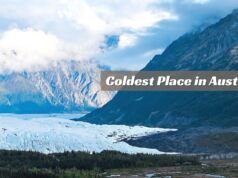










[…] Conservation Park – Think waterfalls and koalas, just 30 minutes […]
Comments are closed.